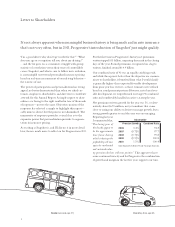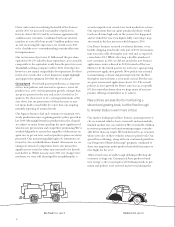Progressive 2011 Annual Report Download - page 19
Download and view the complete annual report
Please find page 19 of the 2011 Progressive annual report below. You can navigate through the pages in the report by either clicking on the pages listed below, or by using the keyword search tool below to find specific information within the annual report.
20
OBJECTIVES AND POLICIES SCORECARD
Financial Results Target 2011 2010 2009 5 Years1 10 Years1
Underwriting margin
–
Progressive 4% 7.0% 7.6% 8.4% 7.2% 9.6%
–
Industry2 n a |||||||| (.4)% (.8)% 1.4% 1.2%
Net premiums written growth
–
Progressive (a) 5% 3% 3% 1% 8%
–
Industry2 n a |||||||| 1% (1)% 0% 3%
Policies in force growth
–
Personal auto (a) 5% 8% 5% 4% 8%
–
Special lines (a) 5% 5% 3% 6% 11%
–
Commercial Auto (a) 0% 0% (5)% 0% 9%
Companywide premiums-to-surplus ratio (b) 2.9 2.9 2.8 na na
Investment allocation
–
Group I (c) 21% 22% 20% na na
–
Group II (c) 79% 78% 80% na na
Debt-to-total capital ratio <30% 29.6% 24.5% 27.5% na na
eturn on average shareholders’ equity
–Net income (d) 16.5% 17.1% 21.4% 15.2% 20.3%
–Comprehensive income (d) 15.0% 22.3% 35.5% 16.2% 21.8%
(a) Grow as fast as possible, constrained only by our profitability objective and our ability to provide high-quality customer service.
(b) Determined separately for each insurance subsidiary.
(c) Allocate portfolio between two groups:
Group I – Target 0% to 25% (common equities; nonredeemable preferred stocks; redeemable preferred stocks, except for 50% of investment-grade redeemable preferred stocks with
cumulative dividends; and all other non-investment-grade fixed-maturity securities)
Group II – Target 75% to 100% (short-term securities and all other fixed-maturity securities)
Note: External data is not available to enable us to report 2009 under our current allocation strategy. For 2009, Group I included common equities, all preferred stocks, and below
investment-grade fixed-maturity securities, while Group II included short-term securities and all other fixed-maturity securities.
(d) Progressive does not have a predetermined target for return on average shareholders’ equity.
na = not applicable
1Represents results over the respective time period; growth represents average annual compounded rate of increase (decrease).
2 Represents private passenger auto insurance market data as reported by A.M. Best Company, Inc. The industry underwriting margin excludes the effect of policyholder dividends.
Final comparable industry data for 2011 will not be available until our third quarter report. The 5- and 10-year growth rates are presented on a one-year lag basis for the industry.
CJ2 (Roy, age 41)Rvrse Prkng (Jaden, age 22) Childhood (Balazs, age 36)
ACHIEVEMENTS
We are convinced that the best way to maximize share-
holder value is to achieve these financial objectives and
policies consistently. A shareholder who purchased 100 shares
of Progressive for $1,800 in our first public stock offering
on April 15, 1971, owned 92,264 shares on December 31,
2011, with a market value of $1,800,071, for a 19.0% com-
pounded annual return, compared to the 6.4% return
achieved by investors in the Standard & Poor’s 500 during
the same period. In addition, the shareholder received
dividends of $36,786 in 2011, bringing their total dividends
received to $379,156 since the shares were purchased.
In the ten years since December 31, 20 01, Progressive
shareholders have realized compounded annual returns,
including dividend reinvestment, of 6.6%, compared to 2.9%
for the S&P 500. In the five years since December 31, 2006,
Progressive shareholders’ returns were (0.7)%, compared to
(0.2)% for the S&P 500. In 2011, the returns were 0.2% on
Progressive shares and 2.1% for the S&P 500.
Over the years, when we have had adequate capital and
believed it to be appropriate, we have repurchased our shares.
In addition, as our Financial Policies state, we will repur-
chase shares to neutralize the dilution from equity-based
compensation programs and return any underleveraged
capital to investors. During 2011, we repurchased 51,298,590
common shares. The total cost to repurchase these shares
was $998 million, with an average cost of $19.45 per share.
Since 1971, we have spent $7.8 billion repurchasing our
shares, at an average cost of $6.69 per share.
























